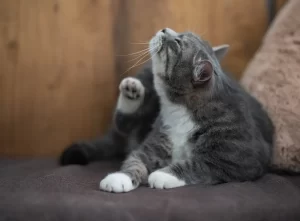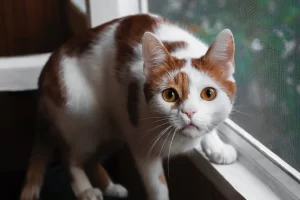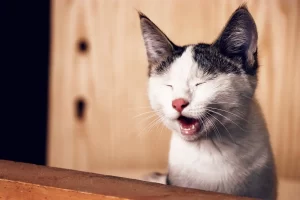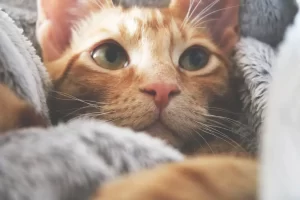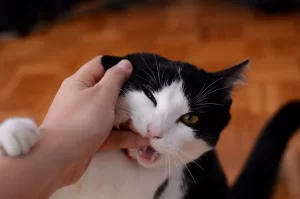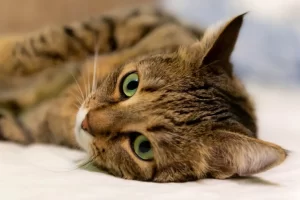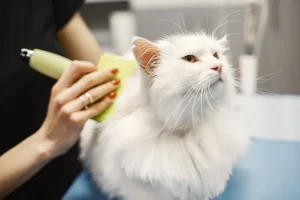Cats are beloved pets and important members of our families. However, like humans, they are susceptible to a variety of health issues, including weepy eyes. Cat weepy eye home remedies can be a safe and effective way to alleviate this condition without the need for expensive veterinary treatments or medication. In this article, we will explore some natural and easy-to-use home remedies for treating weepy eyes in cats. From warm compresses and saline solutions to herbal remedies and nutritional supplements, we’ll cover a range of options to help your feline friend find relief from this uncomfortable condition.
Table of Contents
ToggleWhat is a weepy eye in cats?
A weepy eye in cats is a condition where there is excessive production of tears or discharge in the eye. The underlying causes can include infections, allergies, injuries or anatomical abnormalities. This can result in the fur around the eye becoming wet and matted, leading to skin irritation, inflammation, or infection.
Apart from weepy eyes, the condition can also be referred to as epiphora, watery eyes, tearing, excessive tearing, eye discharge, runny eyes, sticky eyes, gooey eyes, crusty eyes, or matted eyes. It is essential to identify the root cause of weepy eyes in cats to administer appropriate treatment and avoid any potential complications. Therefore, it is advisable to seek veterinary advice if a cat has persistent or recurrent weepy eyes.
Common causes of weepy eyes in cats
There are several common causes of weepy eyes in cats. Some of these include:
- Infections: Bacterial, viral or fungal infections of the eye or surrounding tissues can lead to weepy eyes in cats (check out remedies beneficial for eye infection). The excess tears or discharge help to flush out the infection and protect the eye. Common infections that can cause weepy eyes include conjunctivitis (see the associated home remedies), feline herpesvirus (see the useful feline herpes home treatment methods), and chlamydia.
- Allergies: Cats can develop allergies to various environmental or dietary triggers. These can cause the eyes to become inflamed and produce excess tears. Common allergens that can cause weepy eyes include dust, pollen, mold, and certain foods.
- Obstructed tear ducts: Tear ducts can become blocked or narrowed due to various reasons such as infections, inflammation, or injury. This can cause tears to accumulate and overflow, leading to weepy eyes.
- Corneal ulcers or abrasions: If a cat’s eye is scratched or injured, it can develop a corneal ulcer or abrasion. This can cause pain, inflammation, and excess tearing. Without treatment, the ulcer or abrasion can become infected and lead to further complications.
- Entropion: This is a congenital condition in which the eyelids roll inward, causing the eyelashes to rub against the cornea. This can result in pain, irritation, and excessive tearing.
- Epiphora syndrome: This is a condition where there is an overproduction of tears due to a variety of causes such as abnormalities in the eyelids, eyelashes or tear ducts, or an underlying systemic disease.
Identifying the underlying cause of weepy eyes in cats is crucial to providing the appropriate treatment and preventing any potential complications. If a cat has persistent or recurrent weepy eyes, it is recommended to seek veterinary advice. Read more on How often should I take my cat to the vet?
Identifying the symptoms of weepy eyes in cats: What to look out for
When a cat has a weepy eye, there are several symptoms to look out for. These can help identify the underlying cause and determine the appropriate treatment. Some of the symptoms to look out for include:
- Excessive tearing: This is the most common symptom of weepy eyes in cats. The eyes may produce more tears than normal, leading to wet fur around the eyes.
- Discharge: The tears may be accompanied by a thick or watery discharge, which can cause the fur around the eyes to become matted and sticky.
- Redness or inflammation: The area around the affected eye may appear red, swollen, or inflamed. The cat may also rub or scratch the affected eye due to discomfort. If instead of eye your cat’s face is swollen, it may be because of other underlying diseases that may require other types of remedies.
- Squinting or blinking: The cat may squint or blink frequently due to irritation or pain in the affected eye.
- Cloudiness or opacity: If the weepy eye is caused by a corneal ulcer or injury, the cornea may appear cloudy or opaque.
- Changes in behavior: If the weepy eye is causing discomfort or pain, the cat may show changes in behavior such as being more lethargic, hiding, or avoiding contact.
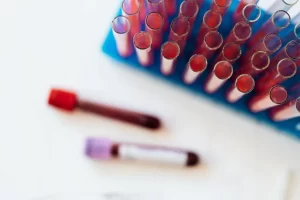
Diagnosing a weepy eye in cats
To diagnose a weepy eye in cats, the veterinarian will typically perform a thorough physical examination and ask about the cat’s medical history. They may also perform additional diagnostic tests depending on the suspected underlying cause. Some of the diagnostic tests that may be performed include:
- Schirmer tear test: This test measures the amount of tear production in the eye to determine if the cat has a tear production abnormality.
- Fluorescein stain: This test involves placing a dye in the eye to help identify any corneal ulcers or abrasions.
- Swab culture: If an infection is suspected, the veterinarian may take a swab from the eye or surrounding tissues to identify the type of bacteria, virus or fungi causing the infection.
- Allergy testing: If an allergy is suspected, the veterinarian may recommend allergy testing to identify the allergen.
- Radiographs or CT scans: If an anatomical abnormality or tumor is suspected, the veterinarian may perform radiographs or CT scans to evaluate the structures surrounding the eye.
- Blood tests: If a systemic disease is suspected, the veterinarian may perform blood tests to evaluate the cat’s overall health and identify any underlying conditions.
Once the underlying cause of the weepy eye is identified, the veterinarian can recommend appropriate treatment. Treatment options may include medications such as antibiotics, antihistamines, or corticosteroids, surgery, or supportive care such as warm compresses or lubricating eye drops.
Potential complications of untreated weepy eyes in cats
If left untreated, weepy eyes in cats can lead to several potential complications. Some of these complications include:
- Secondary infections: Excess tears and discharge around the eyes can create a moist environment that is ideal for bacterial or fungal growth. If left untreated, the infection can spread to the surrounding tissues, causing further damage and potentially leading to systemic illness.
- Corneal ulcers or abrasions: Weepy eyes can cause the cornea to become inflamed and irritated, which can lead to the development of corneal ulcers or abrasions. If left untreated, these ulcers can become infected and potentially cause permanent damage to the eye.
- Blindness: In severe cases, weepy eyes can lead to partial or complete blindness. This can occur if the underlying cause of the weepy eye is not addressed, leading to damage to the structures of the eye or surrounding tissues.
- Discomfort or pain: Weepy eyes can be uncomfortable or even painful for cats, particularly if the underlying cause is an infection, injury or an anatomical abnormality. This can cause the cat to become lethargic, lose their appetite, or display changes in behavior. Consider trying these home treatments specifically designed for lethargic cats.
- Facial dermatitis: The discharge from a weepy eye can cause irritation and inflammation of the skin around the eye, which can lead to the development of facial dermatitis. This can cause further discomfort for the cat and potentially lead to secondary infections.
Cat weepy eye home remedies
Home remedies can be used in conjunction with veterinary treatment to help manage the symptoms of weepy eyes in cats. Here are some main categories of home remedies:
- Warm compresses: Applying a warm compress to the affected eye can help soothe irritation and promote drainage of the excess tears and discharge.
- Saline solution: Rinsing the eye with a saline solution can help flush out any debris or irritants and promote healing.
- Herbal remedies: Certain herbal teas, such as chamomile or green tea, and herbs such as goldenseal, may have anti-inflammatory and antibacterial properties that can help reduce swelling and soothe irritation.
- Nutritional support: Providing a balanced, high-quality diet can help support the cat’s immune system and promote overall health, which can help prevent and manage weepy eyes.
- Soothing agents: Natural soothing agents such as aloe vera gel and coconut oil can help soothe inflammation and irritation in the affected eye. However, be careful not to apply too much of these agents as they can cause further irritation and clog the tear ducts.
- Eye washes: Eye washes are specially formulated solutions that can help clean and soothe the affected eye. They can be purchased from a pet store or made at home with ingredients like boric acid and saline solution.
- Hygiene: Regularly cleaning the cat’s face, particularly around the eyes, with a warm damp cloth can help remove any discharge and prevent further irritation.
Below we will look into each of these items in more detail.
Warm compress therapy for weepy eyes in cats: How to apply and when to use
Using warm compresses can be an effective home remedy to help manage the symptoms of weepy eyes in cats. Warm compresses can help soothe irritation, reduce inflammation, and promote drainage of excess tears and discharge.
Here are some different methods and options for using warm compresses to treat weepy eyes in cats:
- Damp cloth method: Soak a clean, soft cloth in warm water and wring out the excess water. Place the warm, damp cloth over the affected eye and hold it there for a few minutes. Repeat the process several times a day, as needed.
- Microwave method: Dampen a clean cloth with warm water and place it in a microwave-safe dish. Heat the cloth in the microwave for a few seconds until warm (not hot). Place the warm cloth over the affected eye and hold it there for a few minutes. Repeat the process several times a day, as needed.
- Rice bag method: Fill a clean sock or cloth bag with uncooked rice and microwave it for a few seconds until warm (not hot). Place the warm rice bag over the affected eye and hold it there for a few minutes. Repeat the process several times a day, as needed.
When using warm compresses, be sure to:
- Test the temperature of the compress before placing it on the cat’s eye to ensure it is not too hot.
- Use a clean cloth or bag for each application to prevent the spread of infection.
- Be gentle when applying the compress to avoid further irritation or injury to the eye.
Saline solution for weepy eyes in cats: Benefits, uses, and precautions
Using a saline solution can help flush out any debris or irritants from the affected eye and promote healing in cats with weepy eyes. Here are some different methods and options for using the saline solution:
- Homemade saline solution: Mix 1/4 teaspoon of salt with 1 cup of distilled water or boiled tap water (that has been cooled) to make a saline solution. Make sure to use a clean container to mix the solution. You can use this solution to rinse the cat’s eye by using an eyedropper or a syringe without a needle. Apply a few drops of the solution to the eye, holding the eyelids open, and then use a clean cloth to wipe away any discharge.
- Over-the-counter saline solution: You can purchase the saline solution from a pharmacy or pet store. Make sure to choose a solution that is specifically designed for eye use and does not contain any additives or preservatives. Follow the instructions on the packaging for use.
- Saline eyewash: Saline eyewash is a pre-packaged solution that can be used to rinse the cat’s eye. Follow the instructions on the packaging for use.
When using saline solution, be sure to:
- Use a clean container and clean hands to avoid introducing bacteria into the solution.
- Use a separate container for each eye to avoid cross-contamination.
- Use a gentle touch when applying the solution to the eye to avoid causing further irritation.
Herbal and natural remedies for weepy eyes in cats: Effective treatments without side effects
Herbal and natural remedies can be used as complementary treatments for weepy eyes in cats. However, it is important to note that not all herbs and natural remedies are safe for cats, and some can even be toxic. Before using any herbal or natural remedy, consult with a veterinarian to ensure it is safe and appropriate for your cat. Here are some examples of herbal and natural remedies that may be used to treat weepy eyes in cats:
- Chamomile tea: Chamomile tea can help soothe irritation and inflammation in the eyes. Brew a cup of chamomile tea and let it cool down. Dip a clean cloth in the tea, wring out the excess, and then apply it to the affected eye. Repeat several times a day, as needed.
- Aloe vera: Aloe vera can help reduce inflammation and promote healing. Apply a small amount of aloe vera gel to the affected eye, taking care not to get it in the eye. Repeat several times a day, as needed.
- Witch hazel: Witch hazel has astringent properties that can help reduce inflammation and irritation. Dilute witch hazel with an equal amount of water and apply it to the affected eye using a clean cloth or cotton ball. Repeat several times a day, as needed.
- Coconut oil: Coconut oil can help moisturize the eye and reduce irritation. Apply a small amount of coconut oil to the eyelids, taking care not to get it in the eye. Repeat several times a day, as needed.
- Green tea: Green tea contains antioxidants and anti-inflammatory compounds that can help reduce swelling and irritation. Brew a cup of green tea and let it cool down. Dip a clean cloth in the tea, wring out the excess, and then apply it to the affected eye. Repeat several times a day, as needed.
- Eyebright: Eyebright is an herb that has been traditionally used to treat eye conditions. It has anti-inflammatory and astringent properties that can help reduce inflammation and promote healing. Eyebright can be used as a tea, tincture, or eye rinse. Always consult with a veterinarian before using eyebright or any other herbal remedy.
- Goldenseal: Goldenseal is an herb that has antimicrobial and anti-inflammatory properties. It can be used as a tea, tincture, or eye rinse to help reduce inflammation and fight infection. Always consult with a veterinarian before using goldenseal or any other herbal remedy.
Nutritional support for weepy eyes in cats: Supplements and diet tips
Nutritional support and supplements can be used to help support the overall health of cats and may contribute to reducing the occurrence of weepy eyes. Here are some examples of nutritional support and supplements that may be used to treat weepy eyes in cats:
- Omega-3 fatty acids: Omega-3 fatty acids are anti-inflammatory and can help reduce inflammation in the eyes. Omega-3 fatty acids can be found in fish oil supplements or in foods such as salmon or sardines. Consult with a veterinarian to determine the appropriate dosage for your cat.
- Vitamin C: Vitamin C is an antioxidant that can help reduce inflammation and promote healing. Vitamin C can be found in supplements or in foods such as oranges, kiwis, or bell peppers. Consult with a veterinarian to determine the appropriate dosage for your cat.
- Probiotics: Probiotics can help support the immune system and promote overall health. Probiotics can be found in supplements or in foods such as yogurt or kefir. Consult with a veterinarian to determine the appropriate dosage for your cat.
- L-lysine: L-lysine is an amino acid that can help prevent and treat viral infections that may contribute to weepy eyes. L-lysine can be found in supplements or in foods such as chicken or fish. Consult with a veterinarian to determine the appropriate dosage for your cat.
In addition to nutritional support and supplements, providing a balanced and nutritious diet can also help support the overall health of cats and reduce the occurrence of weepy eyes.
Dietary changes to help with weepy eyes in cats
Dietary changes can be helpful in managing weepy eyes in cats, particularly if the underlying cause is related to allergies or inflammation. Here are some dietary changes that may help:
- Switching to a hypoallergenic diet: If the weepy eyes are caused by allergies, switching to a hypoallergenic diet may help. Hypoallergenic diets are designed to be less likely to trigger an allergic reaction. Talk to your veterinarian about whether a hypoallergenic diet may be appropriate for your cat.
- Adding omega-3 fatty acids: Omega-3 fatty acids have anti-inflammatory properties that can help reduce inflammation in the body, including the eyes. Adding omega-3 fatty acids to your cat’s diet may help reduce the severity of weepy eyes. Sources of omega-3 fatty acids for cats include fish oil, flaxseed oil, and algae-based supplements.
- Increasing hydration: Dehydration can exacerbate weepy eyes, so it’s important to make sure your cat is well-hydrated. Encourage your cat to drink more water by providing multiple sources of fresh water throughout the house and adding wet food to their diet.
- Avoiding potential allergens: If your cat’s weepy eyes are caused by an allergy, try to identify and avoid potential allergens. Common allergens for cats include certain proteins in food, pollen, dust, and mold. Talk to your veterinarian about how to identify and avoid potential allergens.
Preventing weepy eyes in cats: Hygiene practices that help
Preventing weepy eyes in cats through good hygiene practices is an important step in maintaining your cat’s eye health. Here are some hygiene practices that can help:
- Regular cleaning: Wipe your cat’s eyes with a soft, damp cloth or cotton ball to remove any discharge that may accumulate. Make sure to use a clean cloth or cotton ball for each eye to prevent the spread of infection. You can also use a saline solution to clean your cat’s eyes.
- Keeping your cat’s face clean: Cats with flat faces, such as Persians and Himalayans, are prone to weepy eyes due to the shape of their faces. Make sure to keep your cat’s face clean by wiping it gently with a damp cloth. You can also use a baby wipe specifically designed for pets.
- Trimming fur around the eyes: Long hair around the eyes can irritate the eyes and lead to weepy eyes. Regularly trim the hair around your cat’s eyes to prevent irritation.
- Regular grooming: Regular grooming can help prevent weepy eyes by removing any dirt or debris that may irritate the eyes. Use a soft brush to remove any dirt or debris from your cat’s fur.
- Preventing injuries: Injuries to the eyes can lead to weepy eyes. Make sure to keep your cat away from potential hazards, such as sharp objects or other pets that may scratch their eyes.
By practicing good hygiene habits, you can help prevent weepy eyes in your cat and promote their overall eye health. If you notice any signs of weepy eyes, consult with your veterinarian for further evaluation and treatment.

Medications and over-the-counter treatments
There are several medications and over-the-counter (OTC) remedies that can help with weepy eyes in cats. Here are some options:
- Antibiotics: Antibiotics can help treat bacterial infections that may be causing weepy eyes in cats. Your veterinarian may prescribe antibiotic eye drops or ointment to apply to your cat’s eyes.
- Anti-inflammatory drugs: Anti-inflammatory drugs, such as corticosteroids, can help reduce inflammation and irritation in the eyes. Your veterinarian may prescribe an eye drop or ointment containing corticosteroids.
- Antihistamines: Antihistamines can help reduce the symptoms of allergies, which can include weepy eyes. However, not all antihistamines are safe for cats, so it’s important to consult with your veterinarian before giving your cat any medication.
- Artificial tears: OTC artificial tears can help lubricate your cat’s eyes and reduce dryness that may contribute to weepy eyes. Your veterinarian can recommend a safe and effective brand for your cat.
- Eyebright: Eyebright is an herbal remedy that can be used to soothe and relieve irritated eyes in cats. It can be applied topically as a compress or administered orally as a tincture. However, it’s important to consult with your veterinarian before using any herbal remedies.
Surgical options for weepy eyes in cats
In some cases, surgery may be necessary to treat weepy eyes in cats. Here are some surgical options:
- Dacryocystorhinostomy (DCR): DCR is a surgical procedure that creates a new opening between the tear duct and the nasal cavity. This can help improve tear drainage and reduce tearing and discharge from the eyes.
- Entropion surgery: Entropion is a condition where the eyelid rolls inward, causing the eyelashes to rub against the eye and irritate it. Surgery can be performed to correct this condition and prevent further eye irritation.
- Cherry eye surgery: Cherry eye is a condition where the gland that produces tears prolapses and becomes visible as a red mass in the corner of the eye. Surgery can be performed to remove or reposition the gland and prevent further eye irritation.
- Enucleation: In severe cases where the eye is damaged beyond repair, enucleation (removal of the eye) may be necessary to prevent further complications.
It’s important to note that surgery is typically a last resort and is only recommended when other treatments have failed or are not appropriate for the specific condition.
When to consider euthanasia for a cat with chronic weepy eyes?
Deciding when to consider euthanasia for a cat with chronic weepy eyes can be a difficult and emotional decision. Here are some factors that may be considered:
- Quality of life: If the cat’s weepy eyes are causing significant discomfort or pain, and the condition is not responsive to treatment, it may be necessary to consider euthanasia to prevent further suffering.
- Prognosis: If the underlying cause of the weepy eyes is a serious condition such as cancer or a severe infection, and the prognosis for recovery is poor, euthanasia may be the kindest option.
- Financial considerations: If the cost of treatment is a significant burden and the cat’s quality of life is not expected to significantly improve, euthanasia may be considered.
- Owner’s ability to care for the cat: If the owner is unable to provide the necessary care for the cat’s weepy eyes, and the condition is not responsive to treatment, euthanasia may be necessary to prevent further suffering.
Discuss all treatment options, including euthanasia, with your veterinarian, and consider your cat’s individual circumstances before making a decision.


